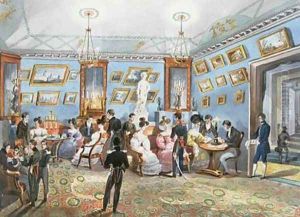Karl Ivanovich Kolmann Paintings
Karl Ivanovich Kollmann (also Karl Ivanovich Kolmann) was a Russian painter and graphic artist known for his work in the early 19th century. He was born in 1786, during a time when Russia was undergoing significant cultural changes and Western influence was on the rise, particularly in the arts.
Kollmann's artistic journey began in his youth, as he displayed an aptitude for drawing. He pursued his passion for art by studying at the Imperial Academy of Arts in St. Petersburg, which was the premier institution for art education in Russia at the time. The Academy was known for its rigorous training and adherence to the neoclassical style, which was prevalent throughout Europe.
During his time at the Academy, Kollmann honed his skills and was influenced by prominent artists of the era. He excelled in his studies and earned several awards for his work, which often depicted historical and mythological themes, a common practice among neoclassical artists.
After completing his education, Kollmann went on to become an esteemed member of the Russian art community. He contributed to the development of fine arts in Russia and was involved in a number of important artistic projects, including the creation of illustrations and engravings for books and periodicals, which were popular at the time due to the rise of the reading public.
Kollmann's works were characterized by their attention to detail, composition, and the use of light and shadow, which reflected the neoclassical influence on his style. His art provided a visual complement to the literary and intellectual movements of his day, capturing the spirit of an era that sought to harmonize Russian traditions with European Enlightenment values.
Karl Ivanovich Kollmann passed away in 1846, leaving behind a legacy as a significant contributor to Russian art. His works remain a testament to the cultural exchange between Russia and the West during a pivotal period in Russian history.
